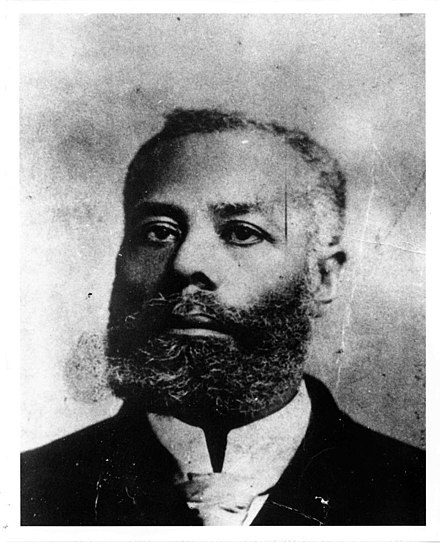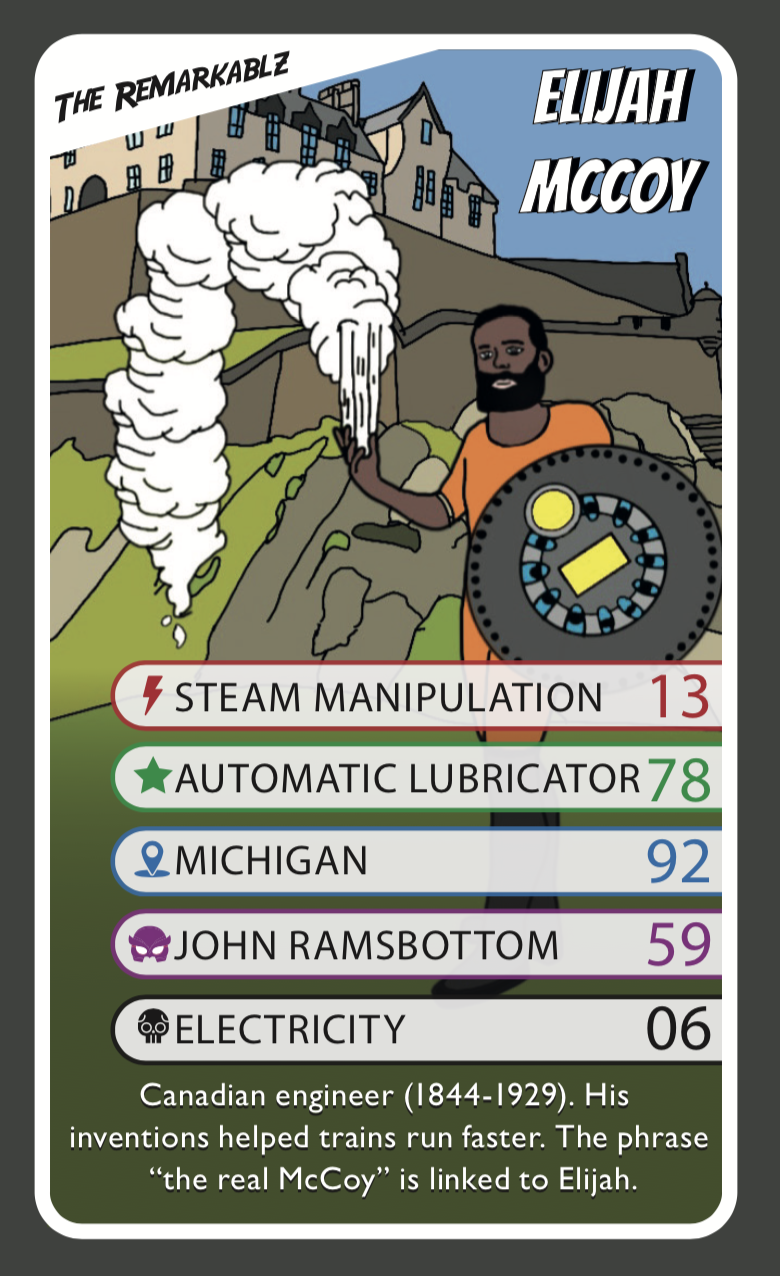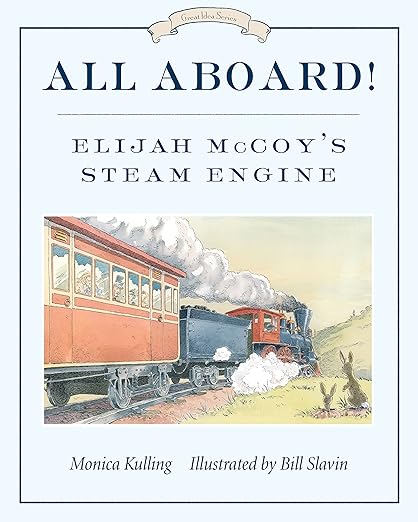
Get to Know
Elijah McCoy
Discover why we turned Elijah into a superhero
WHO WAS ELIJAH MCCOY?
Name: Elijah J. McCoy
Born: 1844
Died: 1929
Occupation: Inventor & Engineer
Nationality: Canadian
Elijah was a Canadian engineer. His most famous invention helped trains run faster.
Elijah's family moved to America when he was a boy and they arranged for Elijah to study mechanical engineering in Scotland. When he returned to America he had trouble finding work so he became a fireman with the Michigan Central Railroad. One of his duties was oiling steam engine parts. In 1872, he developed an automatic lubricator that spread oil evenly over a train's engine while it was still moving. The invention allowed trains to run for long periods of time without stopping.
The phrase "the real McCoy" is thought to be linked to Elijah.
Born: 1844
Died: 1929
Occupation: Inventor & Engineer
Nationality: Canadian
Elijah was a Canadian engineer. His most famous invention helped trains run faster.
Elijah's family moved to America when he was a boy and they arranged for Elijah to study mechanical engineering in Scotland. When he returned to America he had trouble finding work so he became a fireman with the Michigan Central Railroad. One of his duties was oiling steam engine parts. In 1872, he developed an automatic lubricator that spread oil evenly over a train's engine while it was still moving. The invention allowed trains to run for long periods of time without stopping.
The phrase "the real McCoy" is thought to be linked to Elijah.

In The Remarkablz Universe... Elijah was studying at Edinburgh University he became fascinated with Trains. One day during a routine maintenance of a train, Dr Fossil Fuel ignited an oil spill which combined with an overloaded computer system and exploded. Elijah gained his superpowers that day. Elijah soon discovered he could control steam and used his ability to try and get revenge against Dr Fossil Fuel. Elijah can create, shape and manipulate steam.
Superhero Backstory
Elijah features in our signature card game, Top Quarkz. The game supports the development of maths, literacy and decision-making skills all while learning about some of the most impressive scientific discoveries throughout history.
We've explained the drawing and his playing card below so you can learn more.
We've explained the drawing and his playing card below so you can learn more.
Elijah can create, shape and manipulate steam.
- In the background is Edinburgh Castle. At age 15 Elijah was sent to Scotland for an apprenticeship and was later certified as mechanical engineer.
- Elijah's shield is the Smoke box door of a train. This was the hinged circular door on steam engines that allowed service access to the smoke box to fix air leaks.
Superpower
Elijah invented an automatic lubricator for oiling the steam engines of locomotives.
Elijah died in Michigan, on October 10, 1929.
Location
SideKick
John Ramsbottom was an English mechanical engineer. He made steam locomotives in the 1800s.
Many trains are now powered by electricity, which is why we chose electricity as Elijah's weakness.
Weakness
Each drawing we create has one or more hidden treasure(s) about our superheroes' life experiences, depictions in art, jobs or discoveries. Did you find the ones hidden in this drawing?
Discovery

We have packed a lot into our Top Quarkz playing cards - from amazing imagined superpowers to biographical information and hidden treasures.
What Do Mechanical Engineers Do?
Mechanical engineers design, build, and improve machines and mechanical systems. They work on everything from engines and vehicles to robots, heating systems, and tools. Using math, physics, and creativity, they solve problems and create things that move, heat, cool, or operate. Whether it’s designing a high-speed train or improving a wind turbine, mechanical engineers help shape how the world works. Find out more in this video by Institution of Mechanical Engineers.
Elijah McCoy held over 50 patents in his lifetime. His inventions transformed rail travel and industrial machinery—and led to the popular expression “the real McCoy,” a term still used today to mean the genuine article. Learn more about Elijah McCoy in this video by the Foundation for Economic Education.
Steam engines work by using heat to turn water into steam, and then using that steam to make things move. Here’s how it happens: First, water is heated in a boiler until it turns into steam. The steam builds up pressure and is directed into a cylinder. Inside the cylinder, the steam pushes a piston back and forth. This motion turns a wheel or crank, which powers machines—like trains or factory equipment. As the steam cools down, it turns back into water and the cycle starts again.
Steam engines were one of the most important inventions of the Industrial Revolution. In this video SmartyMouse tells you more.
Steam engines were one of the most important inventions of the Industrial Revolution. In this video SmartyMouse tells you more.
- 1. Thomas Savery built the first steam engine in 1698.
- 2. Steam engines powered trains, boats and even huge ships. The Titanic was steam powered!
- 3. Coal is a dirty fuel which is why people don't use steam engines very much anymore.
- 4. Many trains are now powered by electricity, which is cleaner.
Who Was Elijah McCoy?
Fun Facts About Steam Engines
The invention of the train was a major breakthrough in transportation and technology. The first full-scale working railway steam locomotive was built in 1804 by British engineer Richard Trevithick. But it was George Stephenson, in 1829, who made trains practical and popular with his famous locomotive called "The Rocket." The invention of the train made it easier to connect cities, transport goods, and help people travel farther than ever before.
The Invention Of The Train
How Do Steam Engines Work?
All Aboard!: Elijah McCoy's Steam Engine
EDUCATIONAL RESOURCES
Elijah McCoy's dreams led him to study mechanical engineering in Scotland, where he learned how to design and build steam engines. He went on to invent a means of oiling an engine while in motion, changing the face of travel around the world. Find out more in All Aboard!- by Monica Kulling.
Sign up to our Newsletter
By signing up to receive emails, you agree that we may use the personal information provided by you to send you marketing emails. You can opt out of these emails any time by clicking the unsubscribe link or by contacting us. To see how we use your personal data, please see our Privacy policy.





